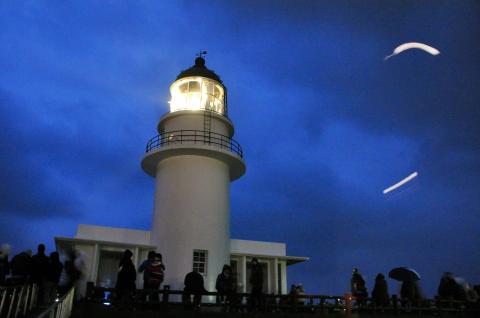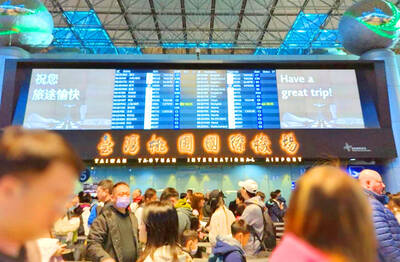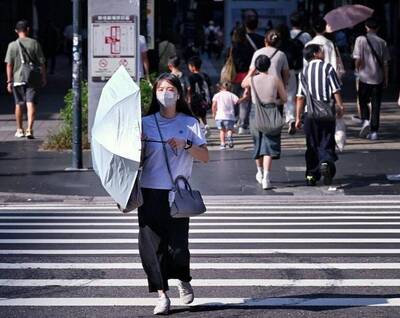The Maritime and Port Bureau under the Ministry of Transportation and Communications yesterday officially replaced the Customs Administration to become the agency in charge of all of the nation’s lighthouses and navigation aids.
To mark the transition of management, the two agencies yesterday jointly unveiled a new lighthouse plaque at the solar energy-powered Keelung lighthouse.
Located in Keelung Port, the 11m-tall brick lighthouse was built in 1900 and the lighting system has a nominal optical distance of 16 nautical miles (29.6km). The nation has a total of 34 lighthouses, 44 light posts and 14 radar beacons, including those in Taiwan proper as well as in the outlying islands of Penghu, Kinmen and Matsu.

Photo: CNA
Maritime and Port Bureau Director-General Li Juel-der (黎瑞德) said the Customs Administration had since 1868 established an excellent system and traditions to manage the nation’s lighthouses.
The bureau will strive to maintain those legacies and seek to improve upon on them, he said.
Li also welcomed the employees from the Department of Marine Affairs, who previously managed the nation’s lighthouses at Customs Administration, to join the bureau.
Li said that the nation’s lighthouses were mostly buildings with long histories and were located in islands with diverse eco-environments.
Yuwongdao (漁翁島) Lighthouse in Penghu County, for example, has been in use since 1778. The granite lighthouse on Dongjudao (東莒島) in Lienchiang County (Matsu), on the other hand, was built in 1872 after the Qing Dynasty lost the opium war against the UK and was forced to open up ports along China’s east coast for trade.
Both lighthouses have been designated as national historical sites by the government, he said.
Li also mentioned the lighthouses in Sandiaojiao (三貂角) and Pengjia Islet (彭佳嶼), both of which were famous for their unique architecture.
According to the bureau, six lighthouses are open to the public — at Yuwengdao, Dongjudao, Cape San Diego, Oluanpi (鵝鑾鼻), Dongyin Island (東引島) and Greater Kaohsiung.
Customs Administration Deputy Director Tseng Ching-yen (曾清煙) said his agency started building lighthouses and other navigation aids in seaports when the Qing dynasty employed British consular official Robert Hart as China’s second inspector-general at the Imperial Maritime Custom Service.
From 1863 to 1911, Hart facilitated the construction of lighthouses and established systems for tax and postal services, he said.
Though the Japanese government managed to build more lighthouses in the colonial era from 1895 to 1945, most of them were severely damaged during World War II, he said.
He said that the Customs Administration took over the management of the lighthouses in 1946 and immediately began restoration work on all the buildings.
Tseng said the nation in 2007 started following the regulations on navigation aids set by the International Association of Marine Aids to Navigation and Lighthouse Authorities, which ensured that the nation’s navigation safety standards are in synch with those of the international community.

Foreign travelers entering Taiwan on a short layover via Taiwan Taoyuan International Airport are receiving NT$600 gift vouchers from yesterday, the Tourism Administration said, adding that it hopes the incentive would boost tourism consumption at the airport. The program, which allows travelers holding non-Taiwan passports who enter the country during a layover of up to 24 hours to claim a voucher, aims to promote attractions at the airport, the agency said in a statement on Friday. To participate, travelers must sign up on the campaign Web site, the agency said. They can then present their passport and boarding pass for their connecting international

Three Taiwanese airlines have prohibited passengers from packing Bluetooth earbuds and their charger cases in checked luggage. EVA Air and Uni Air said that Bluetooth earbuds and charger cases are categorized as portable electronic devices, which should be switched off if they are placed in checked luggage based on international aviation safety regulations. They must not be in standby or sleep mode. However, as charging would continue when earbuds are placed in the charger cases, which would contravene international aviation regulations, their cases must be carried as hand luggage, they said. Tigerair Taiwan said that earbud charger cases are equipped

Temperatures in northern Taiwan are forecast to reach as high as 30°C today, as an ongoing northeasterly seasonal wind system weakens, the Central Weather Administration (CWA) said. CWA forecaster Tseng Chao-cheng (曾昭誠) said yesterday that with the seasonal wind system weakening, warmer easterly winds would boost the temperature today. Daytime temperatures in northern Taiwan and Yilan County are expected to range from 28°C to 30°C today, up about 3°C from yesterday, Tseng said. According to the CWA, temperature highs in central and southern Taiwan could stay stable. However, the weather is expected to turn cooler starting tonight as the northeasterly wind system strengthens again

Taiwan sweltered through its hottest October on record, the Central Weather Administration (CWA) said yesterday, the latest in a string of global temperature records. The main island endured its highest average temperature since 1950, CWA forecaster Liu Pei-teng said. Temperatures the world over have soared in recent years as human-induced climate change contributes to ever more erratic weather patterns. Taiwan’s average temperature was 27.381°C as of Thursday, Liu said. Liu said the average could slip 0.1°C by the end of yesterday, but it would still be higher than the previous record of 27.009°C in 2016. "The temperature only started lowering around Oct. 18 or 19